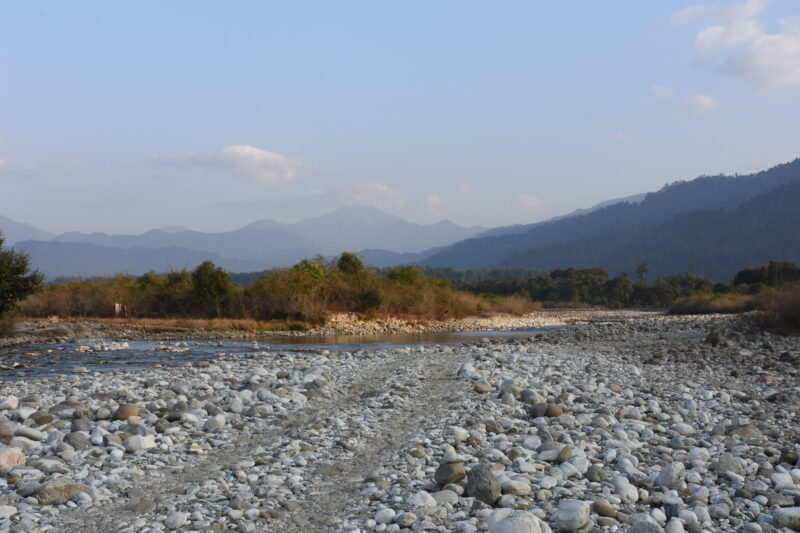
by Karin Dean
“They come from Vijoynagar – they walked over the mountains for one week to come to this festival,” I vividly recall someone telling me, pointing to a group of merry festivalgoers. I was at an ethnic Singpho (Kachin) manau festival in Miao, Arunachal Pradesh, northeast India, in 2004. The men, women and children from the remote village looked not different from others, except for the ethnic Lisu dress worn by some, the dress also donned by the Lisu in Myanmar (Burma), China and Thailand. What is surprising is that some people must walk for 7 days to attend local social events, or to purchase basic necessities—and then walk seven days back—in the 21st century.
Since this encounter, I have wondered what life is like in Daodi – renamed Vijoynagar by the Indian army officer who ‘discovered’ it in 1961, unsure initially whether he was still in India or had crossed into Myanmar. Vijoynagar is in fact a cluster of 16 villages, all located closer to settlements in Myanmar than in India – but all looking to India and a better connection to its bustling centres in valleys. While an Assam Rifles army base has operated there ever since, with a military and – more recently commercial – helicopter transporting both officials and the sick, the connection for most of the area’s nearly 6000 people has been on foot. Recently, however, local jeeps and sturdy cars have begun travelling the 157-km route snaking across mountains, even as its construction still remains unfinished.
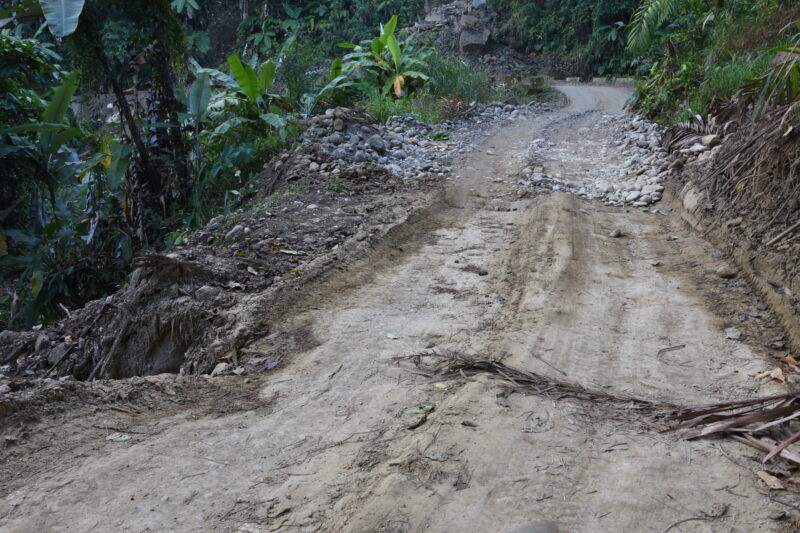
Typical section of the Miao-Vijoynagar Road, January 2023
I got a lift from some local people in their Indian-made Mahindra Thar two-wheel drive jeep and took to the road in January 2023.
ROAD SAGA
Establishing a road link to Vijoynagar, widely considered to be the easternmost inhabited place in India and the remotest circle (or tehsil) of Changlang district is an ongoing saga that has played out for almost 60 years.
The road construction began in 1966, and was completed in 1974. In 1975, the then lieutenant governor of Arunachal Pradesh and his entourage visited Vijoynagar by jeeps. The road, however, quickly fell into disuse due to a lack of maintenance. Different authorities in Arunachal Pradesh State and Delhi later advocated for the road’s repair. But their grappling with questions about funding this expensive infrastructure and its subsequent maintenance has slowed construction. A long-running tug-of-war over responsibility for the road has involved various departments and groups (e.g., Public Works, Border Roads Organization, Forestry Department and ecologists). Complicating the general recognition of the road’s importance for local livelihood and national security are demands by conservationists that the section crossing the Namdapha National Park and Tiger Reserve remain unpaved as the area is a biodiversity hotspot where the Himalayan, Indo-Burmese, and Indo-Chinese flora and fauna meet. All this has kept the construction in limbo. Such a state of continuous delay led a local writer in 2021 to call it an enigmatic road.
In 2023 January, Vijoynagar felt as enigmatic – also because neither the local district government webpage nor Google Maps show that a road overall exists… However, the Miao-Vijoynagar Road, or MV Road as known locally, was very real, when driving at 25—30 km/h felt like ‘speeding,’ as the gravel, mud and uneven tracks often required a much slower pace.
Negotiating mud on the Miao-Vijoynagar Road in January 2023, the peak of the dry season
Two cars passing meant a whole ritual: choosing a suitable—wider—spot, then one vehicle pulling aside and waiting for the other to pass, both maneuvering slowly and carefully.
Driving on the Miao-Vijoynagar Road
But after 8 to 9 hours on the road – with gorgeous views of mountains and deep ravines – the thriving Lisu village of Shidi, officially known by its Indian name Gandhigram, opened up in front of our eyes.
VILLAGE LIFE
Gandhigram is a large and thriving village, with around 500 households aligned along numerous larger and smaller streets. Other villages have 40-50 households on average.
Kids go to school as usual. Larger villages have schools up to grade eight, but the quality of education is a problem due to the lack of qualified staff and supplies. Thus parents who can afford it send their kids to boarding schools in Miao. Families grow subsistence and cash crops suited for the elevation of 1000—1500 meters above sea level, and the monsoon climate. This means rice and potato as the main staple, together with a great variety of vegetables. During my stay at different households, I ate or saw pumpkin, eggplant, bamboo shoots, chilli, beans, lentils, cauliflower, mustard, ginger, garlic, onion, sweet potato and some other roots I did not know. Each Lisu household I saw had black pigs, and hens or ducks. Fish is an essential part of the diet, caught fresh from the river, and upon a good catch served up to three times a day.
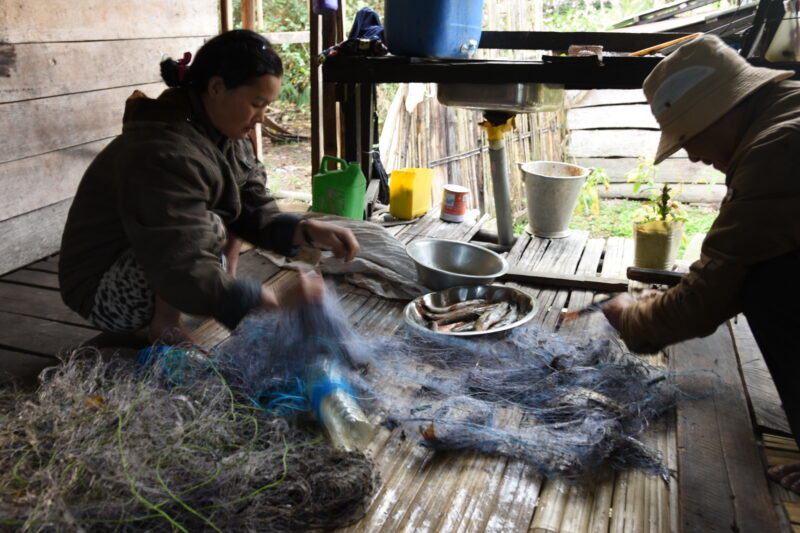
Neighbors teamed up to put nets in the river at night and collect the catch in the early morning
The Lisu houses stand elevated on stilts and have a kitchen with a fireplace for cooking. Cardemmon is the cash crop of the area. Its seeds being light-weight and small, are the easiest to transport to Miao, and can also be kept up to a year before selling, as villagers sometimes wait for a higher price.
All the villagers I talked to said that they had walked the six to seven day journey to Miao “countless times.” Children were taken along when able to walk. During the dry season, the Noa Dihing River sometimes dries up or is very shallow, enabling a shortcut along the river bed that cuts the travel time by up to three days. In the rainy season, the route followed the leach-infested tracks of the old road, damaged by multiple rocks and landslides.
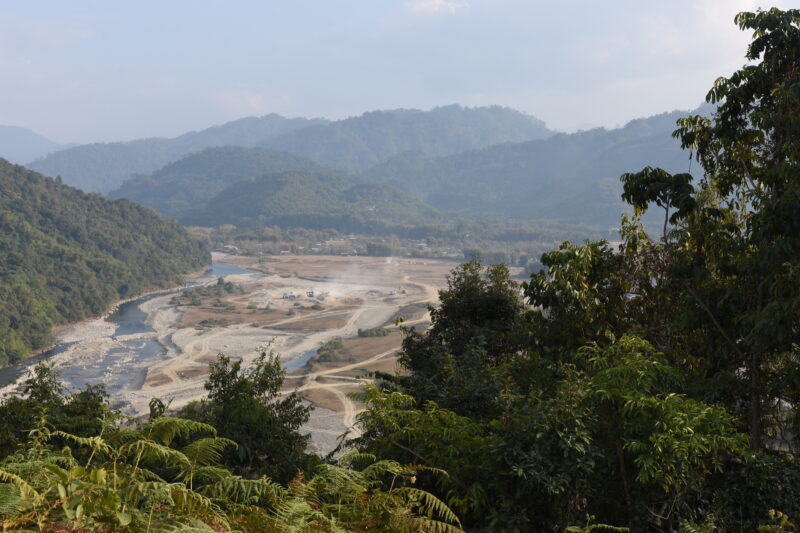
The Noa Dihing River Valley with cris-crossing tracks during the dry season
Driving on temporary car tracks across the river during the dry season
Solar power is the main source of energy and each household receives a free solar panel from the Indian government. Solar powered street lamps line the streets, providing dim light throughout the night. Most villages do not have plumbing, but TV sets and satellite dishes are common, enabling Indian TV programmes. Gandhigram also enjoys virtual connectivity – a few entreprising villagers pay 10,000 rupees (about 110 euros) per month for a setup of a satellite phone, a satellite dish and a receiver enabling 2 GB of data. To make up for the cost but also by popular demand, they offer internet service to others for a small fee – but permit only WhatsApp calls as surfing would take too much of the data allowance. On the other hand, one could call anywhere in the world – and Europe indeed sounded close and clear when I called home.
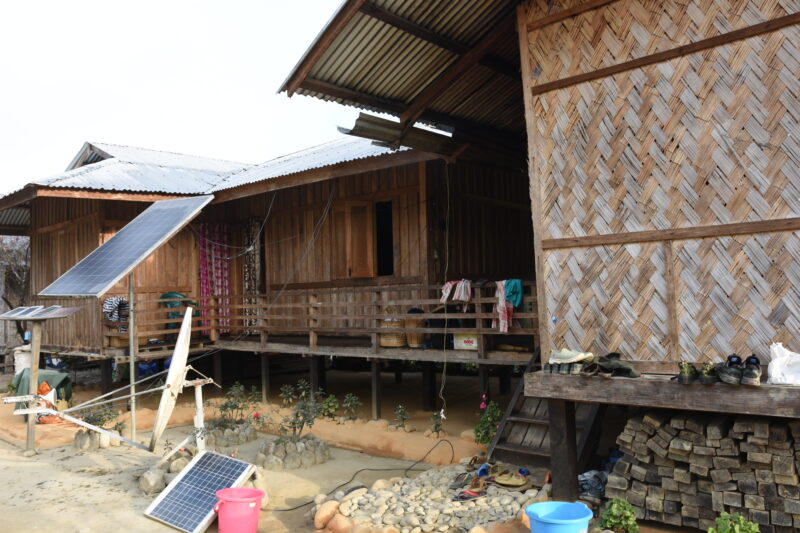
Household in Gandhigram offering internet calls
For everyday logistics, the villagers talk to each other over walkie-talkies. This unique system was introduced by an innovative villager about three years ago, whereby each village, or a section in larger ones, were designated a walkie-talkie channel. By location, everyone knows which channel – out of the 16 total – should be used to reach the people they need. One just has to choose the right channel, call the person out by name or household and start the conversation upon response.
“Before when we wanted to say something, we had to walk and say it. Today we use walkie-talkies,” an elderly man pointed to the benefits of the scheme.
“But no secrets can be talked,” a young woman added. People also play music, or joke over the walkie-talkies.
The continuous ambient chat combined with the buzzing and hissing sound of walkie-talkies accompanied me throughout my stay in Gandhigram.
NEW ROAD FUTURES
Regardless the dynamic village life, all locals straightforwardly and univocally indicated that an all-year drivable road would be “a blessing.” They said that “it’s a dream come true” or that “it’s a big relief for villagers.” On the prospect of the approaching inauguration, they just exclaimed emphatically “amazing!” and “we are very very happy!”
The main reason villagers desire a new road is that easier transportation would lower prices of imports. For decades, the prices for everything from salt to cement have been 5—15 times higher than in Miao, as all has to be brought in on foot. The new road may even pave the way for cell phone tower and electricity to reach the area, as some of the forward looking villagers suggested. But there are also concerns among the community that a rise in alchohol and drug abuse may follow the road.
Some villagers, however, are cautious about the future of the road. “The key question is what will happen after its completion and the inauguration by the Chief Minister,” a young man pointed out.
Namely, Arunachal Pradesh together with the northeast Indian states of Assam and Meghalaya receive some of the highest annual rainfalls in India.
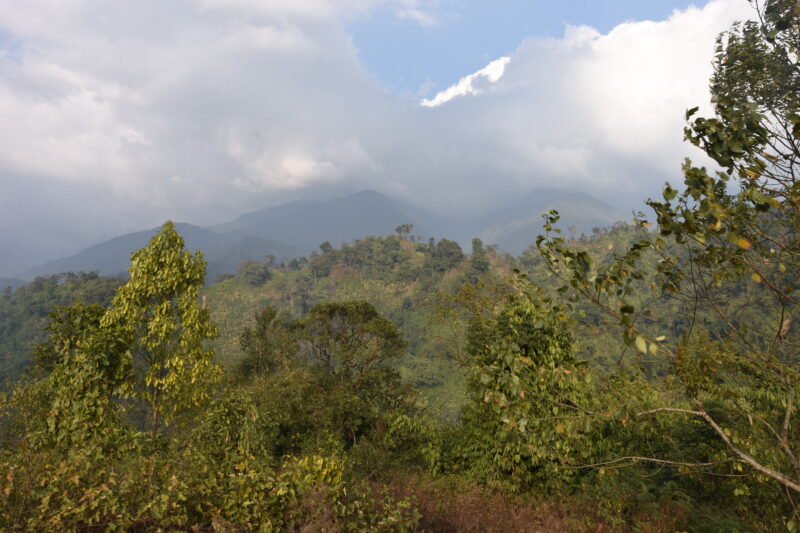
Weather conditions in the mountains may mean rain also during the dry season
The regular southwest monsoon winds that travel westwards along the southern slopes of the Himalayas but are unable to cross over the high altitude range, cause heavy incessant rainfalls from June to September, leading to massive swelling of rivers, frequent landslides and soil erosion in mountains. In the Vijoynagar area, the Noa Dihing River and its tributaries become so ferocious when rains come that several smaller villages get cut off from others. For a road, especially an unpaved one, it is a matter of short time before jungle takes it back – unless the human keeps nature at bay by rebuilding the sections washed away by landslides, erosion or drain water, removes the frequently fallen rocks and keeps the tracks even and drivable when mud dries up. Some villagers wonder whether such maintenance has been made a part of the plan.
“What makes a place remote? Is remoteness a factor of geography and topography, is it a construct of connectivity, or is it an outcome of politics and history?” These are questions raised by Swargajyoti Gohain (2019), an anthropologist writing on cultural identities, borders, mobilities and roads in the Eastern Himalayas and Northeast India, arguing that not only the mountainous terrain but also the politics of access keep many places remote.
Gohain, S. (2019). Selective access: Or, how states make remoteness. Social Anthropology/Anthropologie sociale, 27(2), 204-220. Retrieved Aug 1, 2023, from https://doi.org/10.1111/1469-8676.12650